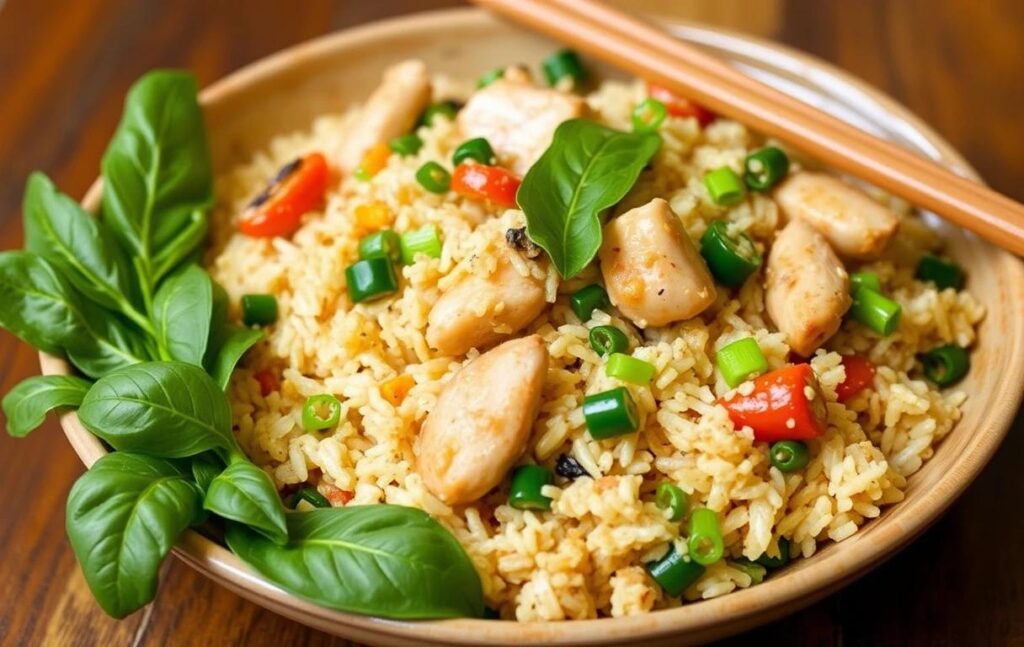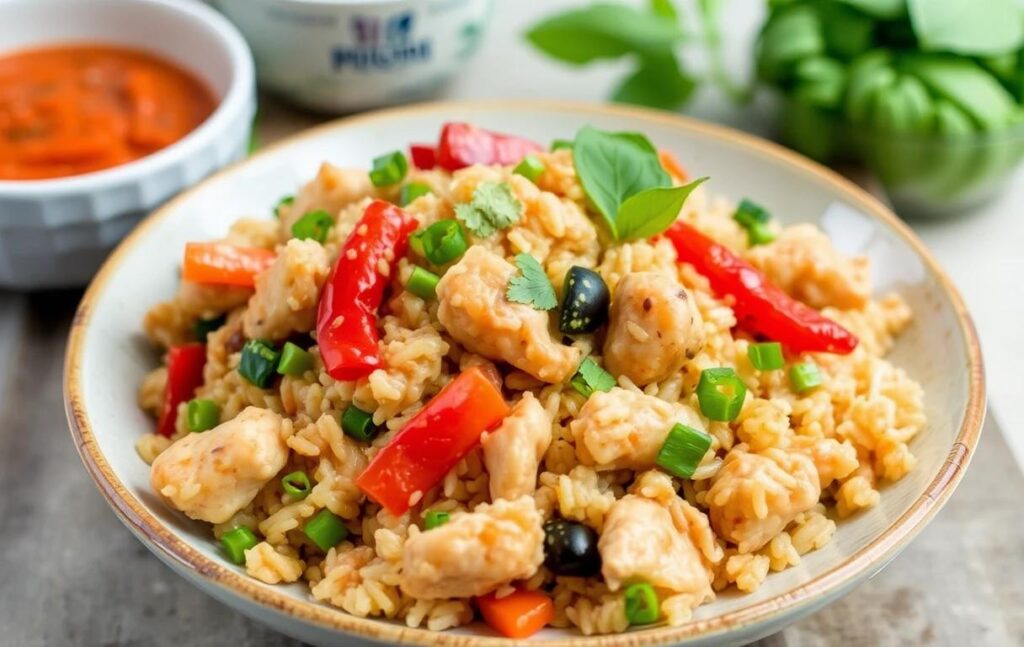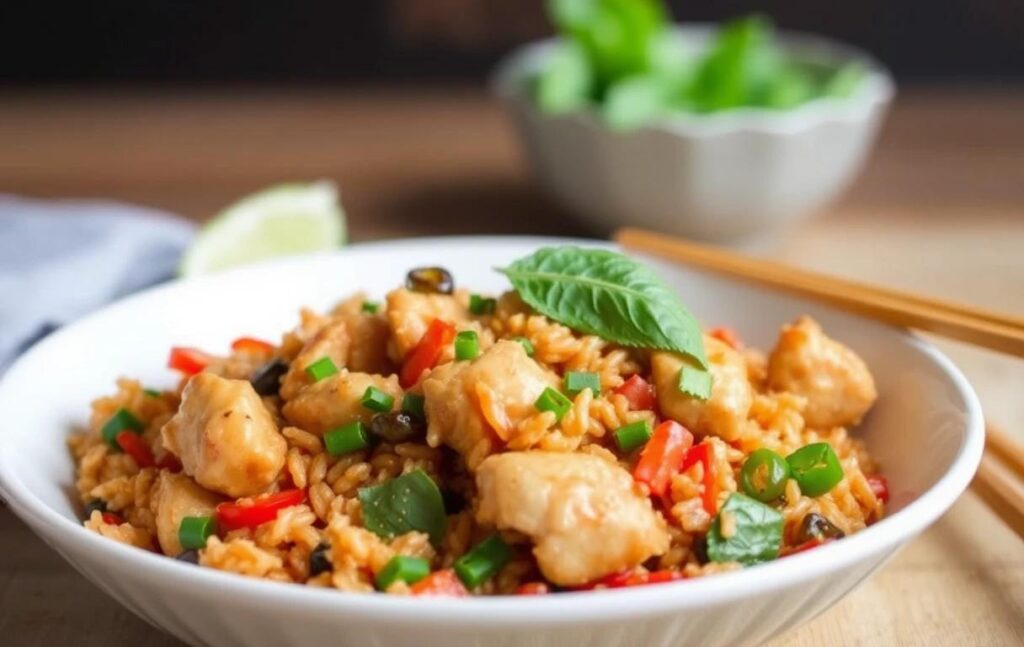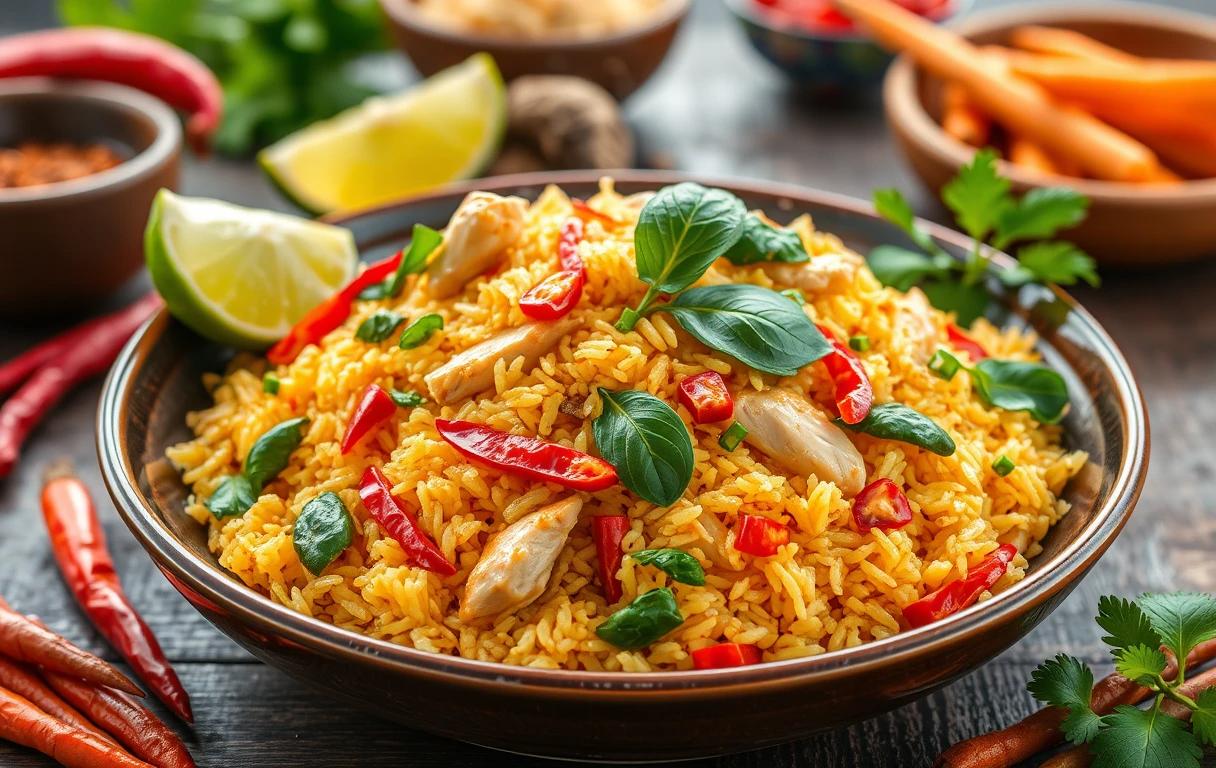Introduction
Thai Basil Chicken Fried Rice is a delightful one-pan meal that combines the bold flavors of Thai cuisine with the comforting texture of fried rice. This dish is a staple in many Thai households and street markets, beloved for its balance of savory, spicy, and aromatic ingredients. The blend of tender chicken, fragrant Thai basil, and umami-rich sauces creates a harmony that is both satisfying and refreshing.
What sets Thai Basil Chicken Fried Rice apart from other fried rice dishes is its unique use of Thai basil, which has a distinctive peppery and anise-like flavor that infuses the rice with an irresistible aroma. Whether you’re seeking a quick weeknight dinner or a dish to impress your guests, Thai Basil Chicken Fried Rice is a versatile recipe that suits any occasion.
In the sections that follow, we’ll dive into the history of this iconic dish, explore its key ingredients, and provide a step-by-step guide to preparing it at home. From understanding the importance of day-old rice to mastering the art of stir-frying, this article will equip you with all the knowledge you need to create the perfect Thai Basil Chicken Fried Rice.
History and Cultural Significance of Thai Basil Chicken Fried Rice
Thai Basil Chicken Fried Rice, or Khao Pad Gai Kaprao, has deep roots in Thai cuisine, reflecting the vibrant flavors and culinary traditions of Thailand. This dish is a fusion of two iconic Thai recipes: Pad Kaprao (stir-fried Thai basil with meat) and fried rice. Combining these two elements creates a meal that is not only delicious but also practical, allowing for easy preparation and customization.
Origins of Thai Basil Chicken Fried Rice
The origins of Thai Basil Chicken Fried Rice can be traced to the traditional use of Thai holy basil (bai kaprao) in Thai cooking. This herb has long been a key ingredient in stir-fry dishes, lending its robust aroma to recipes that often feature chicken, pork, or seafood. The addition of rice, a staple of Thai cuisine, turns a simple stir-fry into a complete, hearty meal.
Fried rice itself is believed to have originated in China, but it has been adapted in Thai cuisine to incorporate local flavors, such as fish sauce, oyster sauce, and fresh chilies. Over time, this dish evolved into the version we know today, combining the spicy, herbal notes of Thai basil chicken with the comforting appeal of fried rice.
Importance in Thai Cuisine
In Thailand, food is more than just sustenance; it is a way of life, and every meal is crafted to achieve a balance of flavors. Thai Basil Chicken Fried Rice embodies this philosophy, bringing together the five key tastes: sweet, salty, spicy, sour, and umami. The result is a dish that is not only nutritionally balanced but also incredibly satisfying.
This dish is a popular choice for busy families, as it is quick to prepare and can be easily adapted to include seasonal vegetables or leftover ingredients. It’s also a common offering at street food stalls, where it is often made fresh to order in sizzling woks over high heat, creating an enticing aroma that draws in passersby.
Regional Variations
While the core ingredients remain consistent, there are slight variations in how this dish is prepared across Thailand. For example:
- Central Thailand: The dish often leans towards a slightly sweeter flavor profile, with more oyster sauce and a touch of sugar.
- Northern Thailand: The use of garlic and chili paste is more prominent, adding extra heat and depth.
- Southern Thailand: Fresh seafood, such as shrimp or crab, may be incorporated to reflect the region’s coastal influences.
These regional twists demonstrate the versatility of Thai Basil Chicken Fried Rice and its ability to adapt to local ingredients and preferences.
Key Ingredients for Thai Basil Chicken Fried Rice
Thai Basil Chicken Fried Rice owes its exceptional taste to the harmonious blend of carefully chosen ingredients. Each component plays a crucial role in building the dish’s layers of flavor, aroma, and texture. Here’s an in-depth look at the key ingredients and their importance in creating this culinary masterpiece.

1. Thai Basil: The Hero of the Dish
The defining ingredient of this dish is Thai basil, specifically the variety known as bai kaprao or holy basil. It has a unique peppery, slightly spicy flavor with hints of clove and anise, which distinguishes it from the sweet basil commonly used in Western cooking.
- Flavor Profile: Adds a bold herbal taste and enhances the dish’s overall aroma.
- Health Benefits: Rich in antioxidants, anti-inflammatory compounds, and essential nutrients like vitamins A and K.
- Substitutes: If Thai basil is unavailable, sweet basil or a mix of mint and basil can mimic some of its flavors, though the result won’t be as authentic.
2. Rice: The Foundation of the Dish
The choice of rice can make or break your Thai Basil Chicken Fried Rice. Traditionally, jasmine rice is used for its delicate fragrance and slightly sticky texture.
- Day-Old Rice: Leftover rice is ideal as it has less moisture, ensuring the grains remain separate when stir-fried. Freshly cooked rice tends to clump together, resulting in a mushy texture.
- Preparation Tip: Spread freshly cooked rice on a tray to cool if you don’t have day-old rice.
3. Chicken: Protein Powerhouse
Chicken is the primary protein in this recipe. Boneless, skinless chicken thighs or breasts are commonly used, as they cook quickly and remain tender.
- Preparation Tips:
- Slice the chicken into thin, bite-sized pieces to ensure even cooking.
- Marinate with a bit of soy sauce or salt for added flavor.
4. Aromatics: Building the Base Flavors
Aromatics are essential for creating a flavorful foundation. This includes:
- Garlic: Finely minced garlic provides a savory depth and blends beautifully with the other ingredients.
- Shallots or Onions: Add a subtle sweetness and enhance the dish’s complexity.
- Chilies: Bird’s eye chilies are traditionally used for heat. Adjust the amount based on your spice tolerance.
5. Essential Sauces and Seasonings
The sauces and seasonings elevate the flavors, balancing the sweet, salty, and umami notes:
- Oyster Sauce: Adds richness and a touch of sweetness.
- Fish Sauce: Provides a savory umami flavor that is quintessential in Thai cooking.
- Soy Sauce: Contributes saltiness and depth.
- Dark Soy Sauce: Optional, for a richer color and slightly caramelized flavor.
- Sugar: A small amount to balance the salt and spice.
6. Vegetables and Add-Ons
While not always included, certain vegetables can add texture and color:
- Bell Peppers: For crunch and sweetness.
- Carrots: Thinly sliced or diced for added color and nutrition.
- Green Beans: A traditional choice for Thai stir-fries.
Optional garnishes such as sliced cucumbers, lime wedges, or fried eggs can also be served alongside the dish.
7. Cooking Oil: The Medium of Flavor
Use a neutral-flavored oil with a high smoke point, such as canola or vegetable oil, for stir-frying. This ensures the ingredients cook evenly without overpowering the dish’s flavors.
8. Optional Toppings and Garnishes
To enhance the dish further:
- Fried Egg: A sunny-side-up egg with a runny yolk adds richness when mixed into the rice.
- Lime Wedges: For a zesty, tangy contrast.
- Chopped Cilantro or Green Onions: Add a fresh, vibrant touch.
Choosing the Right Rice for Thai Basil Chicken Fried Rice
Rice is the heart of any fried rice dish, and selecting the right type and preparing it properly can make all the difference. Thai Basil Chicken Fried Rice demands a fragrant, slightly firm grain that can absorb the bold flavors of the stir-fry without becoming overly soft or clumpy. Let’s explore how to choose, prepare, and handle rice for the best results.

1. The Ideal Type of Rice
The most suitable rice for Thai Basil Chicken Fried Rice is jasmine rice, a staple in Thai cuisine known for its delicate fragrance and soft, fluffy texture when cooked.
- Why Jasmine Rice?
Jasmine rice has a naturally floral aroma that pairs beautifully with Thai flavors. Its texture is soft yet sturdy enough to hold its shape when stir-fried. - Other Options:
- Long-Grain White Rice: An acceptable substitute if jasmine rice is unavailable.
- Brown Jasmine Rice: A healthier alternative, though it has a firmer texture and nuttier flavor.
2. Importance of Day-Old Rice
One of the golden rules of making fried rice is to use day-old rice. Here’s why:
- Reduced Moisture: Freshly cooked rice tends to be moist and sticky, making it prone to clumping during stir-frying.
- Firm Texture: Day-old rice dries out slightly, resulting in separate grains that fry evenly.
- Better Flavor Absorption: Drier rice absorbs sauces and seasonings more effectively, ensuring a flavorful dish.
Pro Tip: If you don’t have day-old rice, spread freshly cooked rice on a baking sheet in a thin layer and refrigerate it for 1–2 hours. This helps reduce moisture quickly.
3. Preparing Rice for Thai Basil Chicken Fried Rice
Follow these steps to cook and prepare rice for the dish:
- Rinse the Rice:
- Rinse jasmine rice under cold water until the water runs clear. This removes excess starch, preventing stickiness.
- Cook the Rice:
- Use a rice cooker, Instant Pot, or stovetop method to cook the rice. Follow a ratio of 1 part rice to 1.25 parts water for perfectly cooked jasmine rice.
- Cool the Rice:
- Allow the rice to cool completely. If possible, refrigerate it overnight for the best texture.
- Break Up Clumps:
- Before stir-frying, gently fluff the rice with a fork or your hands to separate the grains.
4. Common Mistakes to Avoid
- Using Warm Rice: Warm rice releases steam when fried, leading to a soggy texture. Always use cooled or chilled rice.
- Overcooking Rice: Overcooked rice becomes mushy, which is unsuitable for stir-frying. Aim for slightly firm, al dente grains.
- Skimping on Rinsing: Skipping the rinsing step can result in overly sticky rice due to excess starch.
5. How Rice Enhances the Overall Dish
Rice is not just a filler; it acts as the canvas for the bold flavors of Thai Basil Chicken Fried Rice. Properly prepared rice enhances:
- Texture: Each grain should be distinct and slightly chewy, providing a satisfying mouthfeel.
- Flavor: Well-cooked rice absorbs the sauces and aromatics, carrying the dish’s flavor profile in every bite.
- Visual Appeal: Separated grains give the dish a professional, restaurant-quality look.
6. Alternatives to Traditional Rice
For those looking to experiment or accommodate dietary restrictions, consider these options:
- Cauliflower Rice: A low-carb substitute that maintains a similar texture and absorbs flavors well.
- Quinoa: Offers a nutty flavor and a protein-packed alternative.
- Mixed Grains: A blend of jasmine rice with wild or red rice adds variety in texture and color.
Thai Basil: The Star Ingredient
Thai basil is what makes Thai Basil Chicken Fried Rice truly stand out from other fried rice recipes. Its bold and peppery aroma, combined with its unique flavor profile, transforms this simple dish into a fragrant masterpiece. Let’s explore why Thai basil is so essential, its benefits, and what to do if you can’t find it locally.
1. What is Thai Basil?
Thai basil, known as bai horapa in Thai, is a variety of basil commonly used in Southeast Asian cuisines. It belongs to the same family as sweet basil but has distinct characteristics:
- Appearance: Thai basil leaves are darker, narrower, and have purple stems.
- Flavor: Its taste is spicier and more robust, with hints of anise, clove, and pepper.
- Aroma: Its strong fragrance elevates the dish, making it more appetizing and aromatic.
2. Types of Thai Basil
There are three main types of basil used in Thai cooking:
- Thai Sweet Basil (Horapa): Commonly used in curries and stir-fries, including this recipe.
- Holy Basil (Bai Kaprao): Known for its stronger, peppery flavor, traditionally used in Pad Kaprao dishes.
- Lemon Basil (Maenglak): Lighter in flavor, often used in soups or salads.
For Thai Basil Chicken Fried Rice, sweet basil or holy basil is ideal, though the latter adds a more intense kick.
3. How Thai Basil Enhances the Dish
Thai basil’s unique flavor plays several roles in the recipe:
- Flavor Infusion: When stir-fried, the basil releases its essential oils, infusing the rice and chicken with its signature taste.
- Aroma Boost: The herbal aroma complements the savory and spicy notes of the dish.
- Visual Appeal: The vibrant green leaves add a splash of color, making the dish more visually appealing.
4. Nutritional and Health Benefits
Beyond its culinary uses, Thai basil offers several health benefits:
- Rich in Antioxidants: Helps reduce oxidative stress in the body.
- Anti-Inflammatory Properties: Contains compounds that may alleviate inflammation.
- Improves Digestion: Its essential oils can soothe the digestive system.
- Vitamin Content: A good source of vitamins A, C, and K, as well as minerals like iron and calcium.
5. Substitutes for Thai Basil
If you can’t find Thai basil, here are some substitutes:
- Sweet Basil: Lacks the peppery kick but provides a mild, familiar basil flavor.
- Mint and Basil Blend: Combining mint with sweet basil mimics some of Thai basil’s complexity.
- Italian Basil: Similar texture and mild flavor, though it won’t replicate the spice of Thai basil.
- Fresh Cilantro or Dill: Adds a different but refreshing flavor to the dish.
While these substitutes work in a pinch, they won’t fully capture the authentic taste of Thai Basil Chicken Fried Rice.
6. Storing and Preparing Thai Basil
To make the most of Thai basil:
- Storage Tips:
- Keep fresh basil in a jar of water, like a bouquet, and cover loosely with a plastic bag.
- Alternatively, store it in the refrigerator wrapped in damp paper towels.
- Preparation Tips:
- Wash and dry the leaves before use.
- Add basil at the end of cooking to preserve its fresh flavor and texture.
Step-by-Step Recipe for Thai Basil Chicken Fried Rice
Now that we’ve explored the key components of Thai Basil Chicken Fried Rice, it’s time to bring everything together with a detailed step-by-step recipe. Follow these instructions carefully to recreate this authentic Thai dish at home.
Ingredients
For the Main Dish:
- 2 cups cooked jasmine rice (preferably day-old)
- 1 cup chicken breast or thigh, thinly sliced
- 2 tablespoons cooking oil (vegetable or canola)
- 4 garlic cloves, minced
- 2-3 bird’s eye chilies, finely chopped (adjust for spice level)
- 1 small onion or 2 shallots, thinly sliced
- 1 cup Thai basil leaves (lightly packed)
- 1/2 cup diced vegetables (optional, such as carrots, green beans, or bell peppers)
For the Sauce:
- 1 tablespoon fish sauce
- 1 tablespoon oyster sauce
- 1 teaspoon soy sauce
- 1 teaspoon sugar
- 1/2 teaspoon dark soy sauce (optional, for color)
Optional Garnishes:
- Sliced cucumbers
- Lime wedges
- Fried egg (sunny-side-up)

Preparation Steps
1. Prepare the Ingredients
- Cook and cool the rice if you don’t have day-old rice. Spread it out on a tray to remove excess moisture.
- Thinly slice the chicken for even cooking.
- Wash and pat dry the Thai basil leaves.
- Mix the sauce ingredients in a small bowl and set aside.
2. Heat the Pan
- Use a wok or large skillet for this recipe. Heat it over medium-high heat until hot, then add the cooking oil.
3. Cook the Aromatics
- Add minced garlic and chopped chilies to the hot oil. Stir-fry for 30 seconds until fragrant.
- Be careful not to burn the garlic; reduce the heat if necessary.
4. Stir-Fry the Chicken
- Add the sliced chicken to the pan and stir-fry for 2–3 minutes until it is mostly cooked.
- Toss in the onions or shallots and continue stir-frying until the chicken is fully cooked and golden.
5. Add the Vegetables (Optional)
- If using vegetables like carrots or bell peppers, add them at this stage. Stir-fry for 1–2 minutes until tender but still crisp.
6. Incorporate the Rice
- Increase the heat slightly and add the day-old rice to the pan. Use a spatula to break up any clumps, ensuring the rice is evenly distributed.
- Stir-fry for 2–3 minutes to heat the rice thoroughly.
7. Pour in the Sauce
- Drizzle the prepared sauce over the rice and stir-fry quickly to coat all the grains evenly.
- Continue cooking for another 1–2 minutes to allow the flavors to meld together.
8. Add the Thai Basil
- Turn off the heat and toss in the Thai basil leaves. Stir gently to wilt the basil without overcooking it.
9. Plate and Garnish
- Serve the Thai Basil Chicken Fried Rice hot on a plate.
- Garnish with optional toppings such as sliced cucumbers, lime wedges, or a fried egg.
Tips for Perfect Results
- Use High Heat: This helps achieve the smoky, slightly charred flavor characteristic of stir-fried dishes.
- Cook in Small Batches: If doubling the recipe, stir-fry the ingredients in smaller portions to avoid steaming.
- Add Basil Last: Overcooking basil diminishes its fresh, peppery aroma.
Serving Suggestions
Thai Basil Chicken Fried Rice pairs well with:
- Thai iced tea or coconut water for a refreshing drink.
- A side of Tom Yum soup for a more elaborate meal.
FAQs About Thai Basil Chicken Fried Rice
Here are some frequently asked questions to help you master Thai Basil Chicken Fried Rice and customize it to your taste.
1. Can I Make This Dish Vegetarian or Vegan?
Yes! To make a vegetarian or vegan version, replace the chicken with one of the following:
- Tofu: Use firm tofu, cut into cubes, and stir-fry until golden.
- Mushrooms: Button mushrooms or shiitake mushrooms add a meaty texture.
- Plant-Based Protein: Soy-based meat substitutes work well.
Also, swap out fish sauce and oyster sauce with soy sauce or a vegan fish sauce alternative.
2. What Can I Use as a Substitute for Thai Basil?
If Thai basil is unavailable, try these substitutes:
- Sweet Basil: Milder in flavor but works well.
- Mint and Basil Mix: Provides a similar fresh and peppery taste.
- Cilantro: While not identical, it adds a fresh twist to the dish.
3. Can I Use Freshly Cooked Rice Instead of Day-Old Rice?
Fresh rice is not ideal because it’s too moist and sticky. However, if you don’t have day-old rice, here’s a solution:
- Spread freshly cooked rice on a tray or plate.
- Let it cool for 15–30 minutes to reduce moisture.
- Refrigerate for 1–2 hours before using.
4. How Do I Control the Spice Level?
The heat in Thai Basil Chicken Fried Rice comes from bird’s eye chilies. To adjust the spice level:
- Use fewer chilies for a milder dish.
- Remove the seeds before chopping to reduce the heat.
- Add chili paste or chili flakes as a topping for those who prefer more spice.
5. How Do I Store Leftovers?
If you have leftovers, follow these storage tips:
- Refrigerate: Store in an airtight container and keep in the fridge for up to 3 days.
- Reheat: Use a skillet or microwave, adding a splash of water or broth to prevent dryness.
6. What Are Some Variations of This Dish?
You can customize Thai Basil Chicken Fried Rice in many ways:
- Seafood Version: Use shrimp, crab, or squid instead of chicken.
- Egg Fried Rice: Add scrambled eggs to the dish for extra protein.
- Spicy Upgrade: Include more chilies or chili paste for a fiery kick.
7. Is It Gluten-Free?
This dish can be made gluten-free by using gluten-free soy sauce and fish sauce. Always check labels to ensure there are no hidden gluten ingredients.
8. What’s the Best Way to Serve Thai Basil Chicken Fried Rice?
Serve the dish with simple garnishes like cucumber slices and lime wedges for added freshness.
Recipe: Thai Spicy Basil Chicken Fried Rice
Conclusion: Why You Should Try Thai Basil Chicken Fried Rice
Thai Basil Chicken Fried Rice is more than just a meal; it’s an experience that brings the essence of Thai cuisine to your table. With its bold flavors, enticing aromas, and easy preparation, this dish is perfect for any occasion. Whether you’re a seasoned cook or a beginner in the kitchen, this recipe offers a simple yet rewarding way to explore the vibrant world of Thai food.
By mastering the use of essential ingredients like Thai basil, jasmine rice, and flavorful sauces, you’ll gain a deeper appreciation for the balance and harmony that define Thai cooking. Plus, the dish’s versatility means you can customize it to suit your dietary needs, spice tolerance, or ingredient availability.
From its cultural significance to its practical preparation tips, this guide has covered everything you need to create a restaurant-quality Thai Basil Chicken Fried Rice at home. So, gather your ingredients, fire up your wok, and enjoy the satisfaction of making this classic Thai dish with your own hands.
For More Recipes
a pretty life in the suburbs marshmallow vanilla buttercream
mississippi mud pie ice cream
boston cream pie near me
vegan barley soup

